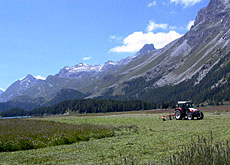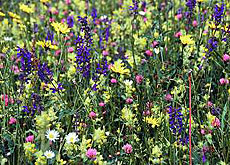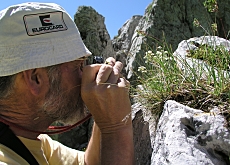Biodiversity under threat in alpine areas

Swiss farming policy needs to be revised to protect biodiversity in the Alps, researchers warn in a study published on Tuesday.
If land use and agricultural subsidies are not reconsidered, a large number of alpine plant and animal species will continue to decline and eventually disappear, they say.
Since the mid-1990s, Swiss agricultural policy has turned away from market intervention, and guaranteed prices and markets for farmers to so-called direct payments.
These payments are intended to compensate public services – ensuring food supply, maintaining the landscape and preserving social structures, for example, as well as ecological services such as preserving habitats for animals and plants.
But the authors of the study on the alpine agricultural and forestry economies say that the ecological payments are missing their mark and being spent in the wrong place.
“Some farmers in non-alpine areas are subsidised for work they would have done anyway and which is sometimes harmful to the environment,” said Markus Fischer, one of the authors.
Direct payments – the best tool for stemming biodiversity loss in the Alps, according to Fischer – should be targeted more carefully and stricter criteria for the distribution of funds demanded.
Reforms
The researchers suggest reforms of the payment system, such as its regionalisation as well as subsidies for farmers who raise rare breeds of animals or who maintain meadows with low yields.
Other possibilities include service agreements for general activities that ensure the preservation of biodiversity. Any other approach the study says, such as maintaining the status quo or abandoning mountain farming, would have only negative effects.
The suggestion to increase the efficiency of direct payments to stem biodiversity loss is hardly wishful thinking, according to the researchers. They point out that Switzerland’s national legislation, constitution and international treaties ratified in the past demand better protection of biodiversity.
“The higher the biodiversity, the more services we can derive from a landscape,” Fischer told swissinfo. “That can be protection against erosion, protection against natural hazards or cleaner water for example.”
Since the 1950s, the construction of dams, tourism and the rationalisation of agriculture are some of the factors that have contributed to major changes in the alpine landscape.
“Human activities, mainly agriculture, influence biodiversity,” added Fischer. “Farming is now either intensified, which leaves only the dominant species, or land use is abandoned, also modifying the types of species living in an area.”
Vanishing species
Forest surface has been on the rise, for example, taking over areas once used by farmers, but abandoned because of low yields. This means that some species that benefited from agriculture are now vanishing.
“We are seeing a homogenisation of the landscape and in every habitat there is a deterioration of the number of species,” said Fischer.
The researchers say that targeted payments will help foster entrepreneurial spirit in the agricultural community and protect the beauty of the Alps. But they certainly aren’t suggesting that farmers step back in time and provide Heidi-like backdrops for the Swiss tourism industry.
“We aren’t talking about transforming the Alps into a museum,” Fischer told swissinfo. “We are referring to a dynamic ecosystem where evolution takes place, where biological interactions happen.”
swissinfo, Scott Capper
Biodiversity, or biological diversity, is the term for the variety of life and the natural processes of which living things are a part.
This includes :
– genetic diversity – diversity of genes within a species. There is a genetic variability among the populations and the individuals of the same species.
– species diversity – diversity among species in an ecosystem. The Alps are considered a “hotspot” of species diversity.
– ecosystem diversity – diversity at a higher level of organization, the ecosystem.
The system of direct payments was introduced in 1993.
They represent compensation for services provided by farmers and their contribution towards preserving the environment.
Farmers receive these payments only if they meet certain requirements. Key elements include rational use of fertilisers, crop rotation, soil protection, economic and specific use of plant treatment products and animal welfare measures.
General direct payments are compensation for the basic tasks, as set out in the constitution, of ensuring food supplies, maintaining the landscape and helping to preserve social structures in rural areas.
Particular services are remunerated separately through ecological direct payments. Participation in this programme is optional.
Among other things, the farmer receives additional payment for extensive meadowland, natural field margins, and rotation of fallow fields.

In compliance with the JTI standards
More: SWI swissinfo.ch certified by the Journalism Trust Initiative










You can find an overview of ongoing debates with our journalists here . Please join us!
If you want to start a conversation about a topic raised in this article or want to report factual errors, email us at english@swissinfo.ch.